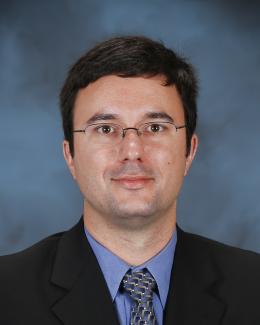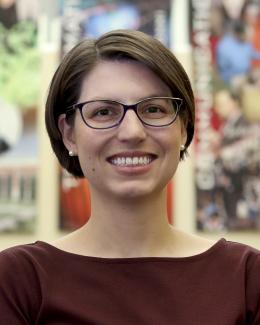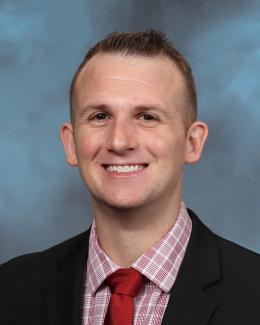Steven Hamilton, an R&D scientist in the HPC Methods for Nuclear Applications group at ORNL, leads the ExaSMR project. ExaSMR was developed to run on the Oak Ridge Leadership Computing Facility’s exascale-class supercomputer, Frontier. Credit: Genevieve Martin/ORNL, U.S. Dept. of Energy
The Exascale Small Modular Reactor effort, or ExaSMR, is a software stack developed over seven years under the Department of Energy’s Exascale Computing Project to produce the highest-resolution simulations of nuclear reactor systems to date. Now, ExaSMR has been nominated for a 2023 Gordon Bell Prize by the Association for Computing Machinery and is one of six finalists for the annual award, which honors outstanding achievements in high-performance computing from a variety of scientific domains.
The ExaSMR project endeavors to make large-scale nuclear reactor simulations easier to access, cheaper to run and more accurate than the current state of the art to aid in the design of next-generation reactors. The Gordon Bell Prize award committee recognized the project for its recent computational achievements on the Oak Ridge Leadership Computing Facility’s exascale-class (a quintillion or more calculations per second) supercomputer, Frontier. The OLCF is a DOE Office of Science user facility at Oak Ridge National Laboratory.
“Winning a Gordon Bell Prize was one of the longshot goals from the beginning of the ExaSMR project, so being named a finalist in collaboration with the ECP’s Center for Efficient Exascale Discretizations project this year is a huge accomplishment for the team,” said Steven Hamilton, ExaSMR project leader and R&D scientist in the HPC Methods for Nuclear Applications group at ORNL. “Achieving high performance from a coupled-physics simulation requires not only experts in the individual domain areas but also people who understand how to fit the pieces together in the correct manner.”
The ExaSMR team ran a multiphysics simulation of a nuclear reactor with the Shift Monte Carlo neutron transport code coupled to the NekRS computational fluid dynamics, or CFD, solver. Shift simulated more than a trillion individual neutron histories with a work rate of approximately 1 billion particles per second — an increase of more than a factor of 100 compared to equivalent calculations performed on the OLCF’s Titan supercomputer in 2016. The CFD problem contained 377 billion degrees of freedom (variables that must be solved for), and NekRS achieved a work rate of 1.4 trillion degrees of freedom per second. That was an increase of a factor of 467 compared to what was achievable on Titan.
“These problem sizes and work rates make it feasible to simulate the conditions inside a nuclear reactor with unprecedented accuracy, producing data that can reduce the need for costly and time-consuming physical experiments and accelerate the development and commercialization process for advanced reactor designs,” Hamilton said.
Although most of ExaSMR’s coupled codes are already well established in science and industry, the ExaSMR team gave them a complete exascale makeover. Since 2016, researchers from ORNL, Argonne National Laboratory, the Massachusetts Institute of Technology and Pennsylvania State University have been optimizing the codes for a new generation of exascale-class supercomputers, such as Frontier and Argonne’s upcoming Aurora, which are accelerated by GPUs.
Shift was originally authored by Thomas Evans, group leader for ORNL’s HPC Methods for Nuclear Applications group, and is now optimized for Frontier. Hamilton and Evans were assisted by ORNL’s Katherine Royston and Elliott Biondo in preparing Shift to run on Frontier.
Shift uses Monte Carlo methods — computational techniques that use many random samples to calculate the probable outcomes of models. In this case, it simulates the interaction between neutrons moving through a nuclear reactor and nuclides, such as isotopes of uranium, an interaction that causes the fission that then creates heat in the reactor’s core. It also models how these isotopes evolve over time to predict the reactor’s life span.
NekRS models how water will move and behave when heated by the reactor’s fuel rods. It was developed at Argonne through the ECP’s CEED project with contributions from Elia Merzari, associate professor of nuclear engineering at Penn State. The ExaSMR team’s Exascale Nuclear Reactor Investigative Code effort, or ENRICO, is led by Paul Romano at Argonne and enables NekRS to interact with either Shift or the similar OpenMC radiation transport code being developed at Argonne.
ExaSMR was originally named after small modular reactors, although its capabilities are also applicable to new advanced reactor concepts, or ARCs. Unlike most commercial nuclear reactors today, SMRs are substantially smaller and use standardized designs, which reduces construction costs and time to production. ARC[s explore new technologies to produce fission power more efficiently and safely. Both efforts utilize computer simulations to predict the viability of proposed designs and to improve them.
The ACM Gordon Bell Prize award winner will be announced at SC23, the International Conference for High Performance Computing, Networking, Storage, and Analysis held on Nov. 14-16, in Denver, Colorado.
UT-Battelle manages ORNL for DOE’s Office of Science, the single largest supporter of basic research in the physical sciences in the United States. DOE’s Office of Science is working to address some of the most pressing challenges of our time. For more information, visit https://energy.gov/science.






